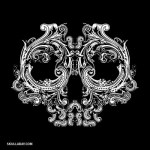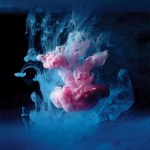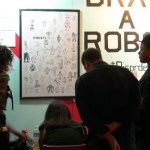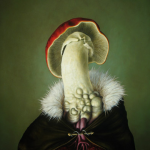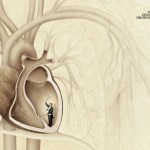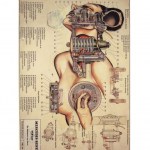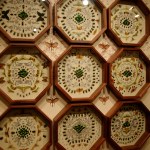Artists & Art
Millennia, 2009
aluminum
Michael Sirvet
Michael Sirvet's aluminum shell, three feet in diameter, is a porous excuse for a bowl (heh heh), but all those edges make lovely sifted patterns of light. Millennia makes me think of a cell membrane, a hollowed-out moon, or the Death Star. I'm not sure which resemblance is cooler. See it at Sirvet's website, or at Artomatic.
Forrest McCluer
A little more explicitly biological than most of the works at Artomatic, Forrest McCluer's six-foot viroid is part of "an ongoing project to deconstruct 30 discarded personal computers and then create sculptures from all their constituent parts."
I'm not even going to start "deconstructing" the layers of meaning in a giant model of a biological virus made out of discarded, outdated computers. . . total bioephemera!
Ornament(al) Skull
Noah Scalin
Anatomophiles alert: tomorrow, Noah Scalin, proprietor of the Skull-A-Day blog and author of Skulls, opens a new show at the Quirk Gallery in Richmond, VA.
I just typed "Richmoaned". Does that qualify as a Freudian slip? Or something else?
mushroom paintings, oil on panel, 2008
Amy Ordoveza
This series of three paintings by Amy Ordoveza works as abstraction from a distance, but close up, they're luminous golden woodland fungi - the quintessence of bioephemera! See more at her website/blog.
Theatre
Ben Tolman
Like Hieronymus Bosch paintings, Ben Tolman's intricate, epic drawings can hold your attention for a long, long time. Although the poor lighting at Artomatic makes poring over the minute detail a little frustrating, it's impressive to see the scale of Tolman's works in person. Alternatively, view the high-res version here, or watch video of Theatre's creation (it took over a year) here, at Ben's blog. I think he may be single-handedly supporting the whole Micron pen industry, at least in the DC Metro area! Awesome work.
Mark Mawson's Aqueous series consists of amazing fluid artworks created by dropping paint into water. I wasn't going to blog about them, because everyone else is already, but I found it remarkable how similar they are to jellyfish - not the one above necessarily, but some of the others. Go to his website and click on "series" to view them all.
Via Behance, via today and tomorrow and lots of other places.
The Age of the Drowning of Sorrows and the miracle of Soju and Etha
oil on canvas
Tracey Clarke
Tracey Clarke has taken nearly every little girl's habit of doodling horses, turned it into startlingly realistic animal portraiture, and then added a frisson of creepiness. Her wild horses, blank-eyed and leaking stuffing, remind me of the Skin Horse from Margery Williams' The Velveteen Rabbit:
"Real isn't how you are made," said the Skin Horse. "It's a thing that happens to you. When a child loves you for a long, long time, not just to play with, but REALLY loves you, then you become Real.""Does…
nmohan of the collaborative artists group Robot Disorder just contacted me to let me know they've launched the Robot Disorder 2.0 website, with more robot hordes (and easier navigation). He says they have literally thousands of robot drawings to clean up and post in the coming weeks, so if you haven't yet seen your personal robot, never fear - it's on its way.
And it's not too late to contribute your own robot to the project - just visit the top floor at Artomatic in Washington DC before July 5!
Her Dark Satanic Mills
Paul Taylor
When I saw Paul Taylor's massive paintings at Artomatic, I immediately thought of two things: fire and Blake's etchings. So I was tickled that the title, "Her Dark Satanic Mills," refers to a poem by Blake, and that Taylor's creative process is all about fire:
The medium is essentially highly flammable furniture stripper gel - set on fire of course. They are canvas pieces mounted on Luan, covered in Polyurethane to protect the canvas. The gel is applied, somewhat in a Pollock-like manner, lit, and then the process takes on a John Cageian-like "chance…
Nápoles #2
acrylic
Fabian H Rios Rubino
It's the last two weeks for DC's Artomatic, which runs through July 5. If you haven't had a chance to go, in addition to losing your chance to Draw A Robot, you're missing a lot of wonderful artwork. For the next week, I'm going to highlight some of the Artomatic artists that especially impressed me, starting with Fabian Rios Rubino. Napoles #2, his only contribution to this year's show, is kind of like what you'd get if Gustav Klimt painted a circuit board: this painting simply glows. View a high-res image here.
. . . at least according to a Japanese researcher, who trained them to differentiate "bad" and "good" children's art.
According to New Scientist,
This isn't Watanabe's first efforts to teach art appreciation to pigeons. In 1995, he and two colleagues published a paper showing that pigeons could learn to discriminate Picasso paintings from Monets - work that earned him that year's Ig Nobel prize. New Scientist plays no role in selecting winners, but Watanabe's latest study make a strong case for another award.
Zing.
Of course, Watanabe first had to determine what was "good" or "bad" art.…
I'm here in DC at the Newseum for the State of Innovation Summit, a collaboration between SEED and the Council on Competitiveness. The crowd is pretty awesome - right now Adam Bly, SEED's CEO, is sitting a few rows from me with E.O. Wilson. Earlier, Wayne Clough, Secretary of the Smithsonian Institution, talked about a conversation he'd had recently with Steven Chu about using the Smithsonian's resources to enhance public understanding of climate change. As he spoke, the intense sunshine of a summer day in DC played across the Smithsonian castle turrets directly behind him (the seventh floor…
Artomatic is one of my favorite things about DC: a cooperative unjuried art gallery in a vacant high-rise, staffed by artists, with live performances and mini-bars on every other floor. It's free (except for the bars). What's not to like? The icing on the top (floor) this year is Draw A Robot - a collective crowdsourced fundraising experiment by the team at RobotDisorder.com.
Draw A Robot is a deliciously haphazard mashup of new tech and low tech. Starting at the low tech end of the process, you sit down with the pens and paper provided at the Draw A Robot booth, and you - wait for it - draw…
Manfungus series 1.2
Christian rex Van Minnen
Christian rex Van Minnen paints rather creepy portraits reminiscent of the Old Masters. At first glance, they look human - but these faces are mushrooms, entrails, garbage and tumorous growths. Disturbing, but fascinating, examples of pareidolia.
Via Coilhouse, who compare Van Minnen to Arcimboldo - but, honestly, I like Van Minnen's work much better.
If you read my February piece for the SEED website on art, science, and synesthesia, you'll remember Christopher Reiger's intriguingly ambiguous painting Synesthesia #1. I'm very pleased to report that it is now available as a limited edition print. I'd also like to call attention to Christopher's unusual sales model - what he calls his "charitable sales model:"
In the fall of 2008, I decided to contribute a significant percentage of every art sale to non-profit organizations that are working to redress environmental and social ails. By generating money for important causes through the sale…
Joanna of Morbid Anatomy is on a quest to locate private collections of medical oddities. She's already sussed out fourteen such hidden wunderkammern and photographed their treasures, but she wants to find more:
"Who are these private collectors, and what sort of treasures do they possess? How might their methods of displaying collections differ from institutional approaches? Are we reaching a historical moment similar to the pre-museum era of private cabinets, in which the most interesting artifacts are now in private rather than public hands?"
It's a really interesting question.…
A beautiful anatomical ad campaign for the Zurich orchestra, via fubiz via Notcot.
Of particular interest I think is this comment on the thread at fubiz, from kmaz: "Music, and overall classical music, plays on emotion, not on the nervous system. instead of putting the music emotion above all, it takes it down heavily and awkwardly, to tie it with simple physic reactions." Really? "Plays on emotion, not on the nervous system"? Pardon me, but to a neurobiologist, that dichotomy is nonsensical. Our emotions and our nervous systems are inextricably entwined. Further, the complex physics and…
Der Mensch als Industriepalast (Man as Industrial Palace)
Fritz Kahn, 1926
Pintura/Anatomias, Sintonizando
Fernando Vicente, 2000
The suddenly blogospherically ubiquitous pinup-artist turned anatomical illustrator Fernando Vicente is clearly influenced by German artist Fritz Kahn. If this is your cup of tea, you'll probably also like "An Iconography of the Industrial Body: Fritz Kahn, Popular Medical Illustration and the Visual Rhetoric of Modernity," a talk by Michael Sappol of the National Library of Medicine, curator of Dream Anatomy and author of A Traffic of Dead Bodies: Anatomy and…
Curious Expeditions has a great interview with Jennifer Angus, the artist who recently redecorated the Newark Museum's Victorian Ballentine House with dead insects in an installation called "Insecta Fantasia." Wow!
The Museum restored the elegant abode to its original dark wood and horror vaccui (fear of empty space) style. This fear of empty space is often seen in Victorian homes - pictures covering every inch of wall, furniture and carpets covering all available floor space, murals and moulding on the ceilings, objects crowding every surface, elaborate window coverings and stained glass in…
I blogged previously about Jan Vormann, who went around medieval villages near Rome patching holes with Lego. Now Vormann has moved on to Berlin, where he's filling World War II bullet holes with multicolored patches. That's just awesome, on many levels. More photos here.
Vormann is represented by the gallery Jarmuschek + Partner. Via today and tomorrow.
